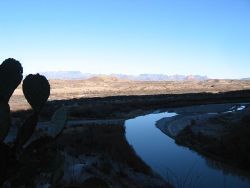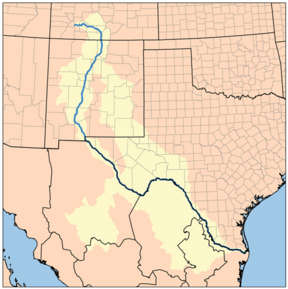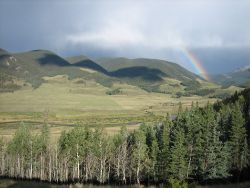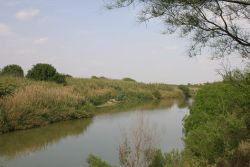Rio Grande
| Rio Grande | |
|---|---|
| Map of the Rio Grande Watershed. | |
| Origin | southern Colorado, in Hinsdale County |
| Mouth | Gulf of Mexico; Cameron County, Texas, and Matamoros municipality, Tamaulipas |
| Basin countries | United States, Mexico |
| Length | 3,034 km (1,885 mi) |
| Source elevation | 3,900 m (12,800 ft) |
| Avg. discharge | averages 160m³/sec |
| Basin area | 607,965 km² (234,737 sq mi) |

Known as the Rio Grande in the United States and as the Río Bravo (or, more formally, the Río Bravo del Norte) in Mexico, this river, 1,885 miles (3,034 km) long, is the fourth longest river system in the United States[1] and serves as a natural boundary along the border between the U.S. state of Texas and the Mexican states of Chihuahua, Coahuila, Nuevo León, and Tamaulipas.
Description
The Rio Grande rises in the east Rio Grande National Forest in the U.S. state of Colorado. It is formed by the joining of several streams at the base of Canby Mountain, just east of the continental divide. From there, it flows through the San Luis Valley, then south into New Mexico through Albuquerque and Las Cruces to El Paso, Texas, where it begins to form the border between the U.S. and Mexico. A major tributary, the Río Conchos, enters at Ojinaga, Chihuahua, below El Paso, and supplies most of the water in the 1,254 miles (2,018 km) Texas border segment. Other known tributaries include the Pecos and the smaller Devils, which join the Rio Grande on the site of Amistad Dam. Despite its name and length, the Rio Grande is not navigable by oceangoing ships, nor are there smaller craft using it as a route. In fact it is barely navigable at all. Its natural flow is only 1/20 the volume of the Colorado River, and less than 1/100 that of the Mississippi.[citation needed]
The river has, since 1848, marked the boundary between Mexico and the United States from the twin cities of El Paso, Texas, and Ciudad Juárez, Chihuahua, to the Gulf of Mexico. As such, it was across this river that Texan slaves fled when seeking their freedom, aided by Mexico's liberal colonization policies and abolitionist stance.[2]
The major international border crossings along the river are Ciudad Juárez and El Paso; Presidio, Texas, and Ojinaga, Chihuahua; Laredo, Texas, and Nuevo Laredo, Tamaulipas; McAllen-Hidalgo, Texas, and Reynosa, Tamaulipas; and Brownsville, Texas, and Matamoros, Tamaulipas. Other notable border towns are the Texas/Coahuila pairings of Del Rio–Ciudad Acuña and Eagle Pass–Piedras Negras.
The US and Mexico share the waters of this river under a series of agreements administered by the joint US-Mexico Boundary and Water Commission. The most notable of these were signed in 1906 and 1944.
Use of that belonging to the US is regulated by the Rio Grande Compact, an interstate pact between Colorado, New Mexico and Texas. The Rio Grande is over-appropriated, that is, there are more users for the water than there is water in the river. Because of both drought and overuse the section from El Paso downstream through Ojinaga was recently tagged "The Forgotten River" by those wishing to bring attention to the river's deteriorated condition. [citation needed]
In the summer of 2001 a 100 m wide sandbar formed at the mouth of the river, marking the first time in recorded history that the Rio Grande failed to empty into the Gulf of Mexico. The sandbar was subsequently dredged, but it re-formed almost immediately. Spring rains the following year flushed the re-formed sandbar out to sea, but it returned in the summer of 2002. As of September 2006, the river once again reaches the Gulf. However, ecologists fear that unless rainfall returns to normal levels during the next few years and strict water conservation measures are adopted by communities along the river, the Rio Grande may soon become extinct.[citation needed]
The Rio Grande rises in high mountains and flows for much of its length at high elevation; El Paso is 3,762 feet (1,147 m) above sea level. In New Mexico, the river flows through the Rio Grande Rift from one sediment-filled basin to another, cutting canyons between the basins and supporting a fragile bosque ecosystem in its floodplain. From El Paso eastward the river flows through desert. Only in the sub-tropical lower Rio Grande Valley is there extensive irrigated agriculture. The river ends in a small sandy delta at the Gulf of Mexico. Due to the persistent period of dry weather, the river has only occasionally emptied into the Gulf Of Mexico since 2002. Google Satellite Map
Millions of years ago, the Rio Grande ended at the bottom of the Rio Grande Rift in Lake Cabeza de Vaca. But about one million years ago the stream was "captured" and began to flow east.
The Rio Grande was designated as one of the American Heritage Rivers in 1997.
Names and pronunciation
Río Grande is Spanish for "Big River" and Río Grande del Norte means "Great River of the North". In English, Rio Grande is pronounced either IPA: /ˈɹiːoʊ gɹænd/ or /ˈɹiːoʊ ˈgɹɑndeɪ/. Because "río" means "river" in Spanish, the phrase "Rio Grande River" is redundant.
In Mexico it is known as Río Bravo or Río Bravo del Norte, "bravo" meaning "fierce" or "brave". There is a city along its banks that bears its name (Río Bravo, Tamaulipas) located 10 miles east of Reynosa, Tamaulipas, and directly across from the Texas city of Donna.
Historically, the Rio Grande/Rio Bravo has been called:
- mets'ichi chena, Keresan, "Big River"
- posoge, Tewa, "Big River"
- paslápaane, Tiwa, "Big River"
- hañapakwa, Towa, "Great Waters"
- tó ba-ade, Navajo, "Female River" (the direction south is female in Navajo cosmology)
Rio del Norte was the most common name for the upper Rio Grande (roughly, within the present-day borders of New Mexico) from Spanish colonial times to the end of the Mexican period in the mid-19th century. Its use was first documented in 1582. The use of the modern English name Rio Grande began with the early American settlers in [south Texas]. By the late 19th century, the name Rio Grande for the entire river, from [Colorado] to the sea, had become standard in the United States.
Rio Bravo had become the standard Spanish name for the lower river, below its confluence with the Rio Conchos, by 1602.
Note that the four [Pueblo] names probably predate the Spanish entrada by several centuries.
See also
| Texas Portal |
- US-Mexico Border
- Rio Grande border disputes
- List of crossings of the Rio Grande
- List of Colorado rivers
- List of New Mexico rivers
- List of Texas rivers
- Rio Grande Wild and Scenic River
- Rio Grande Valley
- Rio Grande Gorge
- Rio Grande Trail
Notes
- ↑ J.C. Kammerer (May 1990). "Largest Rivers in the United States". United States Geological Survey. Retrieved 2006-07-15.
- ↑
 PDF
PDF
ReferencesISBN links support NWE through referral fees
- Horgan, Paul. 1954. Great river: the Rio Grande in North American history. New York: Rinehart. OCLC 597404
- Kearney, Milo, Anthony K. Knopp, and Antonio Zavaleta. 2006. Further studies in Rio Grande Valley history. UTB/TSC regional history series, v. 7. [Brownsville, Tex.]: University of Texas at Brownsville and Texas Southmost College. OCLC 71280470
- Meinig, D. W. 1986. The shaping of America: a geographical perspective on 500 years of history. New Haven: Yale University Press. ISBN 9780300104325
- Riley, Carroll L. 1995. Rio del Norte: people of the Upper Rio Grande from earliest times to the Pueblo revolt. Salt Lake City: Univ. of Utah Press. ISBN 0874804965
External links
All Links Retrieved January 19, 2009.
- Border Stories: the only hand pulled ferry on the Rio Grande (video)
- Rio Grande from the Handbook of Texas Online
- 1854 map of Rio Grande entrance (hosted by the Portal to Texas History).
- Rio Grande Cam - in Mission Texas. Mexico is on the left and the US is on the right.
- Bibliography on Water Resources and International Law from Peace Palace Library
Credits
New World Encyclopedia writers and editors rewrote and completed the Wikipedia article in accordance with New World Encyclopedia standards. This article abides by terms of the Creative Commons CC-by-sa 3.0 License (CC-by-sa), which may be used and disseminated with proper attribution. Credit is due under the terms of this license that can reference both the New World Encyclopedia contributors and the selfless volunteer contributors of the Wikimedia Foundation. To cite this article click here for a list of acceptable citing formats.The history of earlier contributions by wikipedians is accessible to researchers here:
The history of this article since it was imported to New World Encyclopedia:
Note: Some restrictions may apply to use of individual images which are separately licensed.





